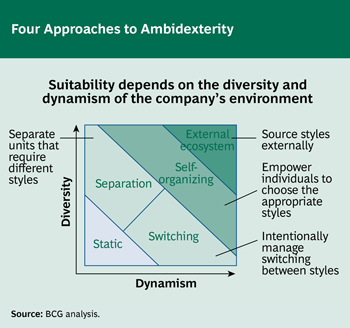 Ambidexterity: The Art of Thriving in Complex Environments
Ambidexterity: The Art of Thriving in Complex Environmentsby Martin Reeves, Knut Haanæs, James Hollingsworth, and Filippo L. Scognamiglio Pasini
This is one of the most important aspects of the MDG framework and an area we spend considerable time on in our Kellogg class. My goal is to entice you to view the entire article
Managers today face an apparent contradiction. On one hand, austerity in the developed world and intense competition push them to cut costs and drive efficiency. On the other, the increasing pace of change means they need to emphasize innovation.
Resolving this contradiction requires ambidexterity—the ability to both explore new avenues and exploit existing ones. Companies need ambidexterity when operating in diverse environments that require different styles of strategy simultaneously, or in dynamic environments that require them to transition between styles over time.
Companies need to be ambidextrous when operating in both emerging and developed markets, when bringing new products and technologies to market while exploiting existing ones, when integrating startups into their existing business, and in a range of other circumstances.
The need to develop ambidexterity is widely acknowledged: in a recent BCG survey of 130 senior executives of major public and private companies, fully 90 percent agreed that being able to manage multiple strategy styles and transition between them was an important capability to develop. But this aspiration is hard to realize. Exploration and exploitation require different ways of organizing and managing….
…..3M, a company renowned for its culture of innovation, experienced the exploration-exploitation tradeoff in the early 2000s, when it introduced Six Sigma practices in an effort to boost productivity. While the company’s productivity did indeed increase, the same practices reduced 3M’s ability to innovate, as evidenced by a fall in the proportion of revenues from new products.
Picking the Right Approach to Ambidexterity (see the article for details
)


No comments:
Post a Comment